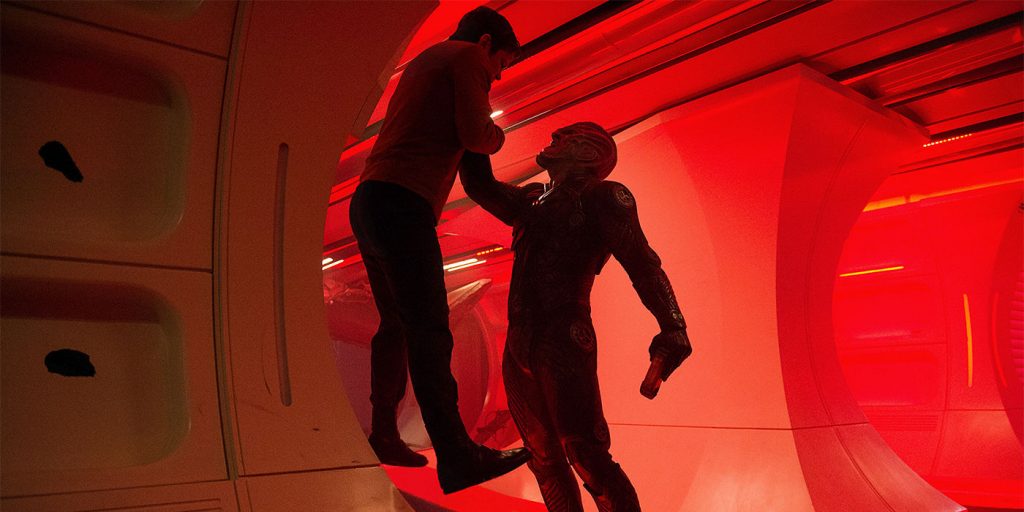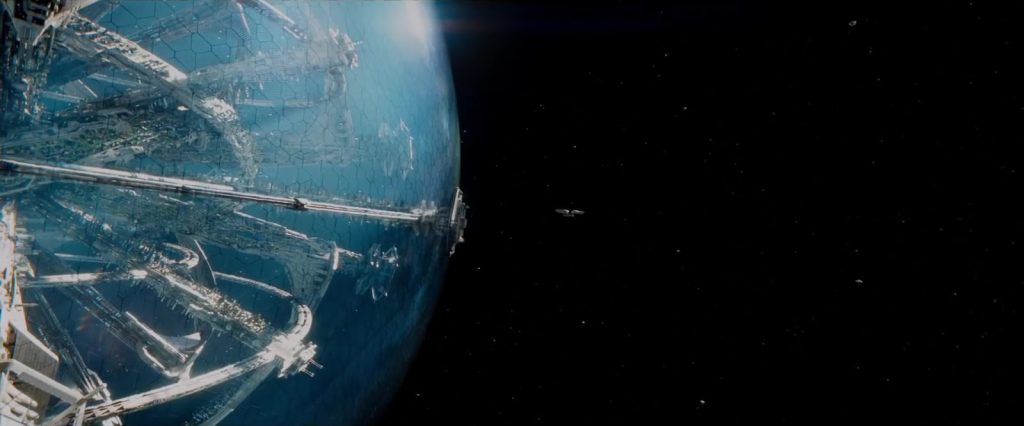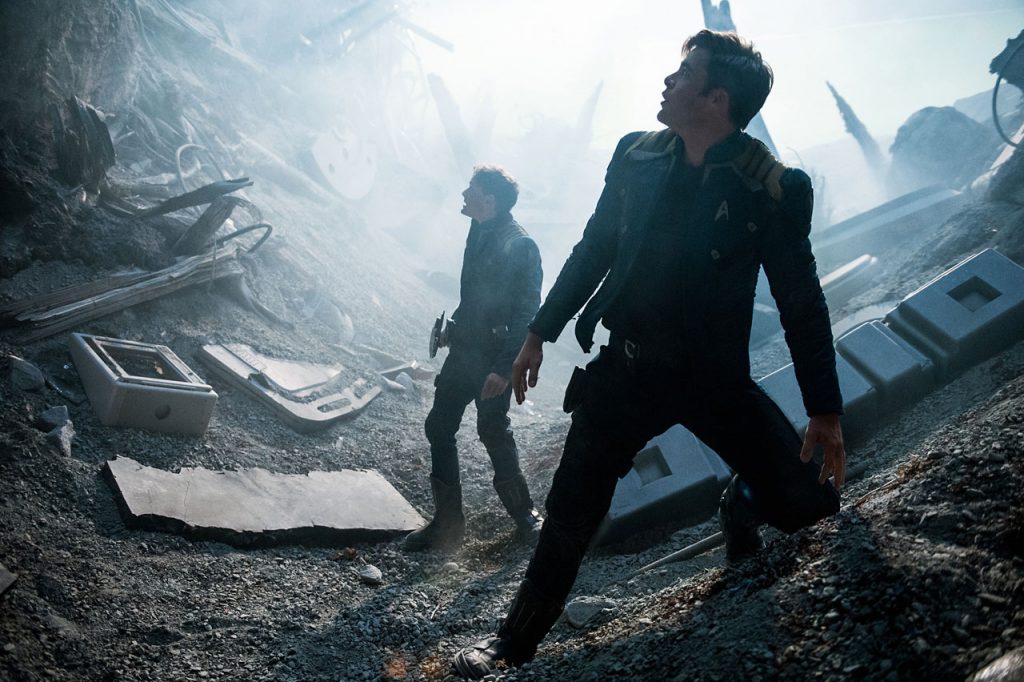 Title: Star Trek Beyond | Rated: PG-13 | Runtime: 120 min | Theaters nationwide
Title: Star Trek Beyond | Rated: PG-13 | Runtime: 120 min | Theaters nationwide
It’s prime time to be a Star Trek fan. Gene Roddenberry’s franchise just celebrated its 50th anniversary, and it has reason aplenty to live long and prosper. A new Trek TV series, Star Trek: Discovery, is scheduled to premiere next year – nearly 12 years after the end of Star Trek: Enterprise. The latest entry in the reboot feature film saga (dubbed the Kelvin timeline), Star Trek Beyond, opened in theaters this past weekend. Furthermore, there’s already a fair bit of chatter regarding its sequel, in which Chris Hemsworth will star. Indeed, any Trekkie (or Trekker) must be over the moon, especially since the recent film is arguably the best in the Kelvin timeline so far.
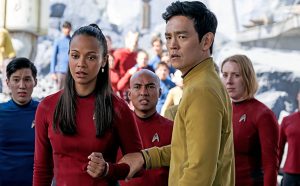 The USS Enterprise is three years into its five-year journey, and the crew shows signs of weariness. Captain James Kirk (Chris Pine) wonders whether he should stay with the ship, as he has recently applied for a promotion to Vice Admiral. The crew dock at the Starbase Yorktown, hoping to enjoy a break from daily life aboard the Enterprise. Their rest doesn’t last long, as they soon head into the other side of a nebula to rescue an alien crew. There, they come under attack from an unidentified race, forcing them to abandon the ship once it is damaged beyond repair. Now scattered across a strange planet, they must regroup and find a way to return to space, all while attempting to avoid the wrath of the villainous Krall (Idris Elba), who seeks to unleash a powerful weapon.
The USS Enterprise is three years into its five-year journey, and the crew shows signs of weariness. Captain James Kirk (Chris Pine) wonders whether he should stay with the ship, as he has recently applied for a promotion to Vice Admiral. The crew dock at the Starbase Yorktown, hoping to enjoy a break from daily life aboard the Enterprise. Their rest doesn’t last long, as they soon head into the other side of a nebula to rescue an alien crew. There, they come under attack from an unidentified race, forcing them to abandon the ship once it is damaged beyond repair. Now scattered across a strange planet, they must regroup and find a way to return to space, all while attempting to avoid the wrath of the villainous Krall (Idris Elba), who seeks to unleash a powerful weapon.
My exposure to Trek is limited compared to most. I never really watched any of the TV series apart from an episode or two of Star Trek: Voyager (most likely when I was channel-surfing out of boredom), and even then, I never felt compelled to watch that show regularly simply because it didn’t interest me at that age. I only caught on to the franchise after watching J.J. Abrams’ Star Trek in 2009, which charmed me with its energy and cast. That positive encounter led me to eagerly anticipate Star Trek Into Darkness in the buildup to its release. While I will concede that it’s a storytelling mess (which becomes more apparent upon repeat viewings), I still enjoy it. After that, I started to read a bit about the original TV series and came to understand why the franchise is well regarded and valued by so many. I still haven’t watched any of the shows, though I plan on watching Discovery next year. I suppose I’m a very casual Trek fan, though that’s only because I like the Kelvin timeline movies.
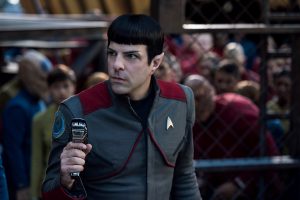 What’s surprising about Beyond is how self-contained it is. You definitely don’t need to have watched Into Darkness before this, as there aren’t any references to the events in that film, most evidenced by the absence of Alice Eve’s Carol Marcus (which seems harsh since it would be nice to have more women in the main cast). If anything, it feels more like a natural sequel to the 2009 film, but even then, any references to that film mostly come in the form of throwaway lines and a neat graphic or two. Beyond that, it has plenty of room to operate however it likes, and it does just that by setting itself apart from the other two films. This is truly a simple and straightforward story; the plot is not convoluted at all, and screenwriters Doug Jung and Simon Pegg (also playing Montgomery “Scotty” Scott) ensure that from scene to scene, the characters’ actions and motivations are – for the most part – clear and sensible. There is neither time travel nor politics to contend with, which allows the film to tackle the franchise’s roots and focus on its characters.
What’s surprising about Beyond is how self-contained it is. You definitely don’t need to have watched Into Darkness before this, as there aren’t any references to the events in that film, most evidenced by the absence of Alice Eve’s Carol Marcus (which seems harsh since it would be nice to have more women in the main cast). If anything, it feels more like a natural sequel to the 2009 film, but even then, any references to that film mostly come in the form of throwaway lines and a neat graphic or two. Beyond that, it has plenty of room to operate however it likes, and it does just that by setting itself apart from the other two films. This is truly a simple and straightforward story; the plot is not convoluted at all, and screenwriters Doug Jung and Simon Pegg (also playing Montgomery “Scotty” Scott) ensure that from scene to scene, the characters’ actions and motivations are – for the most part – clear and sensible. There is neither time travel nor politics to contend with, which allows the film to tackle the franchise’s roots and focus on its characters.
The franchise has long been a celebration of diversity and exploration, and that very spirit permeates this picture, which separates it from its two predecessors. As the film depicts the beings that populate this universe, we see women, people of color, gays, and aliens – all of whom influence the story in meaningful ways. Setting the story predominantly on one planet allows the exploratory nature of the franchise to bloom, leading to many moments where characters discover new things and rattle off scientific jargon when finding solutions to their problems. When the film takes us to Yorktown, it knows this is a place that we’re not familiar with, so the camera lingers on the city’s technical advancements and marvelous design as well as the society’s inclusiveness, making us explore the Starbase quite intimately. Given that this year marks the 50th anniversary of Trek, these are very appropriate ways of honoring the franchise.
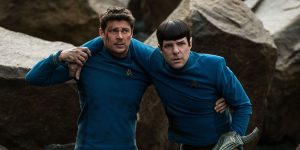 Standing front and center here are the characters. I think that following the fans’ tepid response to Into Darkness, Jung and Pegg – along with director Justin Lin – took a hard look at the Kelvin timeline saga and felt that they had to reorient it in order to move forward. They do that by making Beyond a character-centric film, and it pays off very well. The characters’ arcs – namely Kirk, Spock (Zachary Quinto), and alien scavenger Jaylah (Sofia Boutella) – and their relationships with one another drive the story. While Kirk’s inner conflict doesn’t resolve as convincingly as it should, Spock and Jaylah’s arcs play out very clearly and wonderfully. The fact that the crew is separated into pairs – Kirk and Pavel Chekov (Anton Yelchin), Spock and Leonard “Bones” McCoy (Karl Urban), Scotty and Jaylah, and Hikaru Sulu (John Cho) and Nyota Uhura (Zoe Saldana) – upon abandoning the Enterprise is a terrific plot point, as we get to see how they bounce off of, influence, and depend on each other. Some pairs are complementary like Kirk and Chekov as well as Sulu and Uhura, while others feature some irresistible head-butting like Spock and Bones in addition to Scotty and Jaylah. This goes hand in hand with the franchise’s theme of diversity, particularly how it can lead to unity. It also gives the cast plenty of material to work with and show off their chemistry with one another, with the standouts being a fierce Boutella, an inquisitive Quinto, and exasperated Urban.
Standing front and center here are the characters. I think that following the fans’ tepid response to Into Darkness, Jung and Pegg – along with director Justin Lin – took a hard look at the Kelvin timeline saga and felt that they had to reorient it in order to move forward. They do that by making Beyond a character-centric film, and it pays off very well. The characters’ arcs – namely Kirk, Spock (Zachary Quinto), and alien scavenger Jaylah (Sofia Boutella) – and their relationships with one another drive the story. While Kirk’s inner conflict doesn’t resolve as convincingly as it should, Spock and Jaylah’s arcs play out very clearly and wonderfully. The fact that the crew is separated into pairs – Kirk and Pavel Chekov (Anton Yelchin), Spock and Leonard “Bones” McCoy (Karl Urban), Scotty and Jaylah, and Hikaru Sulu (John Cho) and Nyota Uhura (Zoe Saldana) – upon abandoning the Enterprise is a terrific plot point, as we get to see how they bounce off of, influence, and depend on each other. Some pairs are complementary like Kirk and Chekov as well as Sulu and Uhura, while others feature some irresistible head-butting like Spock and Bones in addition to Scotty and Jaylah. This goes hand in hand with the franchise’s theme of diversity, particularly how it can lead to unity. It also gives the cast plenty of material to work with and show off their chemistry with one another, with the standouts being a fierce Boutella, an inquisitive Quinto, and exasperated Urban.
Where the film falls short is its villain. Krall has the makings of a good villain: he’s a foil to our main protagonist (Kirk), he’s threatening, and we can empathize with him once his backstory comes to light. However, the filmmakers mishandle him, and he clearly doesn’t work as well as they want him to. The issue with Krall lies in a major revelation about him that is revealed near the climax. I won’t reveal what it is, but you can see it coming from a mile away, and because the filmmakers hold it off, it comes far too late, unfortunately coinciding with a rather rushed third act. That revelation concerns his backstory, and because it comes so late, it becomes an information dump that tries to make us empathize with him with little time remaining. It would’ve been better had that moment come earlier in the second act so that he becomes a complex villain earlier and has time to sink into the story’s emotional landscape. Elba is fine in the role, but the writing and the makeup – which keeps him from delivering an expressive performance – limit his abilities.
 Beyond certainly has its shortcomings, but they don’t detract from how fun it is throughout. Much like the Abrams films, it bursts with tremendous energy, but I’d argue that this film flows and pops more naturally because it’s quite confident in what it’s doing. The filmmakers find a strong balance between drama and humor; the loss of the Enterprise and Krall’s menace ring true, and the humor manifests in the crew’s interactions with one another, typically when they’re bickering. Lin is terrific at creating and staging action sequences (aside from a few hand-to-hand fight scenes that are filmed with the dreaded shaky cam), and here, they deliver thrills in spades. The action still revolves around these characters, and not only do their motives and personalities come through, we invest in these sequences even more because we care about the outcomes.
Beyond certainly has its shortcomings, but they don’t detract from how fun it is throughout. Much like the Abrams films, it bursts with tremendous energy, but I’d argue that this film flows and pops more naturally because it’s quite confident in what it’s doing. The filmmakers find a strong balance between drama and humor; the loss of the Enterprise and Krall’s menace ring true, and the humor manifests in the crew’s interactions with one another, typically when they’re bickering. Lin is terrific at creating and staging action sequences (aside from a few hand-to-hand fight scenes that are filmed with the dreaded shaky cam), and here, they deliver thrills in spades. The action still revolves around these characters, and not only do their motives and personalities come through, we invest in these sequences even more because we care about the outcomes.
This is a well crafted film, where the technical elements generally enhance the overall experience. Cinematographer Stephen F. Windon captures some really neat shots of the Enterprise traveling through space, and his camera deftly zips across planes of action. The film’s sharp editing team have the art of cross-cutting down to a T. The visual effects are grandiose and stellar, especially when the story first takes us to the awe-inspiring Yorktown and when Krall’s forces attack and destroy the Enterprise in a breathtaking sequence. Michael Giacchino’s dynamic score beckons us across an entire spectrum of emotions, and it’s quite affecting when it plays over the film’s most heartfelt moments. The sound design and mixing shine during the action sequences, though the mixing for Krall’s voice does make his dialogue unintelligible at times.
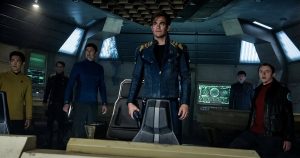 Star Trek Beyond fittingly celebrates a landmark anniversary of the franchise. In proudly espousing Trek values of diversity, exploration, and unity as well as focusing on its eclectic group of characters, it not only pays tribute to Roddenberry’s legacy, but also serves as a necessary fresh breath of air for the Kelvin timeline saga. Now that it has reoriented and found its own soul, it can push the frontier further and boldly go where none has gone before.
Star Trek Beyond fittingly celebrates a landmark anniversary of the franchise. In proudly espousing Trek values of diversity, exploration, and unity as well as focusing on its eclectic group of characters, it not only pays tribute to Roddenberry’s legacy, but also serves as a necessary fresh breath of air for the Kelvin timeline saga. Now that it has reoriented and found its own soul, it can push the frontier further and boldly go where none has gone before.
Rating: 4.0/5.0
* Photos courtesy of Paramount Pictures



